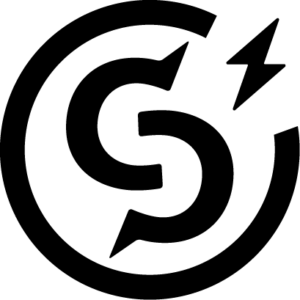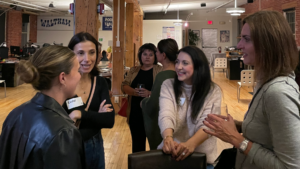February 5, 2024 / Thought Leadership
CP’s Empowering Women Network
Michele Hart-Henry, Managing Director, CP Health
Fostering Growth and Connection
In January, we were thrilled to host our second women’s networking event, attended by over 60 women from various industries, ages, and career stages across Boston. Our Empowering Women Network event series aims to create an environment that encourages genuine connections and conversations, acknowledging that women and men network differently [1]. Our focus aligns with the broader trend of women’s networking events, which provide a safe space for women to share experiences and challenges [2].
 Why Does an Advertising Agency Host Networking Events?
Why Does an Advertising Agency Host Networking Events?
Networking is crucial for women in the workplace – any workplace – as it helps them identify role models, find mentors and sponsors, and expand their business relationships. The way we see it, though, it goes beyond just connecting with people; it’s about building a community to share ideas, solve problems, and create opportunities for one another. And since so many of our clients and employees are women, it’s a logical way for us to support them.
When I approached our President, Steve Connelly, about starting the series, he threw his support behind the idea. As he said recently, “I don’t know what you all talk about or do since you won’t let me in, but I know this is important for us to support.” In fact, so many of our people see the importance of this effort that we have a whole army – women and men – who work behind the scenes to make sure the events go off without a hitch.
 As I explained to Steve and to everyone who attends or asks, our goal isn’t exclusion. There are well-researched gender differences in forming networks and discrepancies in access to and use of networks, making it more important for women to have psychosocial and social support [3].
As I explained to Steve and to everyone who attends or asks, our goal isn’t exclusion. There are well-researched gender differences in forming networks and discrepancies in access to and use of networks, making it more important for women to have psychosocial and social support [3].
Among our goals for forming the series, along with enjoying food, beverages and fellowship in our really cool and inviting space, is to use the event to share helpful information that our guests and our employees can implement in their personal and professional lives.
During our first event, we focused on networking 101 basics – name tag placement, handshakes, and using QR codes instead of business cards. This time, we broke into smaller groups and discussed imposter syndrome, exploring whether it’s an intrinsic or a workplace issue and discussing strategies to combat it [4].
 More Events on Tap
More Events on Tap
The Empowering Women Network series will continue, sponsored by our agency. Future events will continue to focus on topics relevant to women in the workforce, providing a platform for discussion, connection, and empowerment. The goal is to support women in their professional journeys, helping them navigate challenges and celebrate successes in a supportive and inclusive environment.
Our next gathering is slated for this coming spring and we’d love to have more women join us! If you’d like to be on our mailing list for that event, or if you’d like to learn more about our network, email me at MHartHenry@ConnellyPartners.com.
 brief us?
brief us?






 At CP, we are always asking “why?” We’re fascinated and ever curious about customer mood and mindset. Here’s a few observations and constructive fodder for discussion from our anthropology and strategic planning teams from this past quarter.
At CP, we are always asking “why?” We’re fascinated and ever curious about customer mood and mindset. Here’s a few observations and constructive fodder for discussion from our anthropology and strategic planning teams from this past quarter. Observation:
Observation:  Observation: Snoop Dogg broke the internet with his news: “I’ve decided to give up smoke.” Days later he revealed it was a stunt for Solo Stove, a company that makes smokeless fire pits. The out-of-category jump made the impact all the more unexpected. By reversing a core identity, Solo Stove created shock value and instability. When the campaign is revealed, they simultaneously soothe anxieties and reassert the Snoop brand.
Observation: Snoop Dogg broke the internet with his news: “I’ve decided to give up smoke.” Days later he revealed it was a stunt for Solo Stove, a company that makes smokeless fire pits. The out-of-category jump made the impact all the more unexpected. By reversing a core identity, Solo Stove created shock value and instability. When the campaign is revealed, they simultaneously soothe anxieties and reassert the Snoop brand. Observation:
Observation:  Observation:
Observation: 

 In a world where making meaningful connections in professional settings can be difficult, I feel extremely grateful that Connelly Partners recognizes this and helps provide me and my female colleagues with the warmth, support, and empowerment needed to successfully network.
In a world where making meaningful connections in professional settings can be difficult, I feel extremely grateful that Connelly Partners recognizes this and helps provide me and my female colleagues with the warmth, support, and empowerment needed to successfully network.  Not only was I given the privilege of being surrounded by a room full of driven females from all different backgrounds, but this became an opportunity for us to get to know one another in a safe space for authentic connection. Whether it was talking business or simply forming friendships, the women in attendance were eager to share their experiences, advice, insights, and wisdom. It was uplifting to see genuine connections forming rather than just mere business transactions.
Not only was I given the privilege of being surrounded by a room full of driven females from all different backgrounds, but this became an opportunity for us to get to know one another in a safe space for authentic connection. Whether it was talking business or simply forming friendships, the women in attendance were eager to share their experiences, advice, insights, and wisdom. It was uplifting to see genuine connections forming rather than just mere business transactions. 